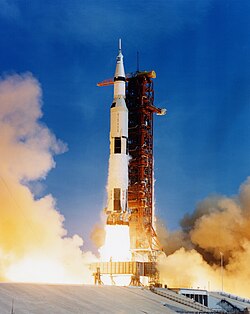Saturn V
American human-rated launch vehicle From Wikipedia, the free encyclopedia
Remove ads
Saturn V was the launch vehicle used by NASA in the Apollo program. The Saturn V carried Apollo 11 to the Moon in 1969, after years of trial, study, and research into its design. Much of the rocket was designed by German engineer and scientist Wernher von Braun, who had previously created the V2 rocket under Nazi Germany. 32 Saturn-model rockets were sent up into space in total, with the launches split between the smaller Saturn I, and its bigger sibling, the Saturn V.[6] 15 Saturn V rockets were made, and 13 were sent up to space for missions.[6] There were two Saturn V's launched with no people in them, used as 'dress rehearsals', with the first manned Apollo flight using a Saturn V being Apollo 8, which was sent around the Moon on December 21, 1968.[7]

The Saturn V rocket was a three-part machine. It stood 111 metres (363 feet) high and weighed 2,903,020 kilograms (6,400,060 pounds). The first rockets were able to carry 44,600 kilograms (98,300 pounds), which went up to 46,800 kilograms (103,200 pounds) for the later Apollo flights.[6] The first and second stages gave the power needed to lift the rocket off of Earth, intended to break through the atmosphere, so that the weaker third stage could go the rest of the way. The first and second stages each had five engines. The first stage burned kerosene and liquid oxygen together, with the other stages burning a mixture of liquid oxygen and liquid hydrogen.[6]
The first stage engines burned for 168 seconds and was able to lift Apollo about 93 kilometres (58 miles) off of from the launch pad. The second stage burned for about 8 minutes, in order to take Apollo through the upper atmosphere. By this time, it was traveling at 25,182 kilometres per hour (15,647 miles per hour).
The third stage was used for 2 minutes and 30 seconds to put Apollo into an Earth orbit. This was at a height of 191.2 kilometres (118.8 miles) above the Earth. The third stage was started again and burned for 6 minutes to make the speed go up to 40,320 kilometres per hour (25,050 miles per hour) needed to send Apollo off to the Moon.[7]
Remove ads
Related pages
Notes
- Includes mass of Apollo Command/Service Modules, Apollo Lunar Module, Spacecraft/LM Adapter, Saturn V Instrument Unit, S-IVB stage, and propellant for translunar injection
- Includes S-II/S-IVB interstage
- Includes Instrument Unit
References
Other websites
Wikiwand - on
Seamless Wikipedia browsing. On steroids.
Remove ads

